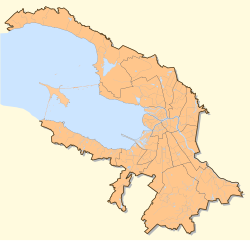Sestroreetsk
| city
Sestrorezk
Сестрорецк
|
||||||||||||||||||||||||||||||||||
|
||||||||||||||||||||||||||||||||||
|
||||||||||||||||||||||||||||||||||
| List of cities in Russia | ||||||||||||||||||||||||||||||||||
Sestrorezk ( Russian Сестрорецк , Finnish Siestarjoki , Swedish Systerbäck ) is a city at the mouth of the Sestra River in the Gulf of Finland , about 35 kilometers northwest of the city center of Saint Petersburg . Administratively it belongs to the district health resort of the city of Saint Petersburg and has 37,248 inhabitants (as of October 14, 2010).
history
A Swedish village on the site of today's Sestrorezk was first mentioned in 1643. In 1714 a new settlement was founded here by Tsar Peter the Great , which was later named Sestrorezk after the river Sestra (Sestrorezk = literally "city on the river Sestra"). In 1724 an arms factory was built there under the direction of Georg Wilhelm Henning , which was one of the leading armaments manufacturers in the Russian Empire in the 19th century .
In the middle of the 19th century, Sestroreetsk served as a military base, for example during the Crimean War . From the late 19th century, the vicinity of Sestrorezk developed into a popular dacha and local recreation suburb due to its scenic location between the Gulf of Finland and extensive coniferous forests .
In 1875, on the horse-drawn tram along the beach promenade, Fjodor Pirozki experimented with electric propulsion in rail transport over a distance of one kilometer.
On June 16, 1925 Sestrorezk received city rights, with the simultaneous incorporation of several surrounding villages. From the formation of the Leningrad Oblast on August 1, 1927, the city was directly subordinate to its Leningrad Okrug . With the abolition of the okrug classification of the oblasts Sestrorezk came on August 19, 1930 to the newly formed Prigorodny rajon ("Vorstadtrajon") of the Leningrad Oblast. On August 16, 1936, the Rajon was dissolved again, and Sestrorezk - like Shlisselburg as another city in the Rajon - directly subordinated to the Oblast administration.
During World War II , the city was held by the Red Army during the Leningrad blockade , but the front line to the Finnish forces was immediately north from September 1941 to June 1944.
After the end of the war, Sestrorezk was detached from the oblast on October 22, 1946 as the center of a newly formed Sestrorezki rajon and placed under the administration of the Leningrad City of Soviet , as was Terijoki to the west (renamed Zelenogorsk in 1948 ) with the likewise new Kurortny rajon (" Health resort rajon ”). In May 1959 the two Rajons were united as Kurortny rajon with seat in Sestrorezk as the largest place; in this form, the Rajon as part of Saint Petersburg largely exists to this day (the western part was again temporarily independent as the Selenogradski rajon between 1989 and 1994 ).
During the Soviet era, a number of sanatoriums and rest houses were built in Sestrorezk, in which a number of prominent people were treated. The former arms factory in Sestrorezk has been known since 1918 as the "Sestrorezker Equipment Factory".
Population development
| year | Residents |
|---|---|
| 1926 | 11,025 |
| 1939 | 28,212 |
| 1959 | 25.205 |
| 1970 | 31,605 |
| 1979 | 29,441 |
| 1989 | 35,498 |
| 2002 | 40,287 |
| 2010 | 37,248 |
Note: census data
Attractions
The most famous historical sights of Sestrorezk include the Dubki Landscape Park , which housed a summer residence of Peter the Great at the beginning of the 18th century, as well as the town cemetery with a number of graves of famous people and a collective burial site from the Second World War .
traffic
Sestrorezk is on the Saint Petersburg - Vyborg - Helsinki railway line .
From Sestrorezk you can get to the island city of Kronstadt , which is part of the KAD ring road , via the northern part of the Petersburg dam over the Neva Bay .
Personalities (selection)
- Leonid Andrejew (1871-1919), writer, lived in Sestrorezk
- Yuri Morozov (1934–2005), soccer coach, is buried in the Sestrorezk cemetery
- Sergei Mossin (1849–1902), weapons designer; was the director of the Sestroetsk arms factory and is buried in the Sestoretsk cemetery
- Alexander Panschin (1863–1904), speed skater and figure skater
- Mikhail Soschtschenko (1894–1958), writer, lived in Sestoreetsk and is buried in the Sestoreetsk cemetery
- Kornei Tschukowski (1882–1969), poet, lived in Sestrorezk
- Nikolai Jemeljanow (1872–1958), Russian revolutionary, born and died in Sestrorezk
Individual evidence
- ↑ a b Itogi Vserossijskoj perepisi naselenija 2010 goda. Tom 1. Čislennostʹ i razmeščenie naselenija (Results of the All-Russian Census 2010. Volume 1. Number and distribution of the population). Tables 5 , pp. 12-209; 11 , pp. 312–979 (download from the website of the Federal Service for State Statistics of the Russian Federation)
- ↑ a b History of the administrative structure of Leningrad Oblast on the website of the Sankt-Peterburgski informazionno-analitischeski Zentr (Russian)
Web links
- Website of the administration of the Kurortny rajon with Sestrorezk (Russian)
- Sestrorezk on mojgorod.ru ( Memento from January 10, 2011 in the Internet Archive ) (Russian)




